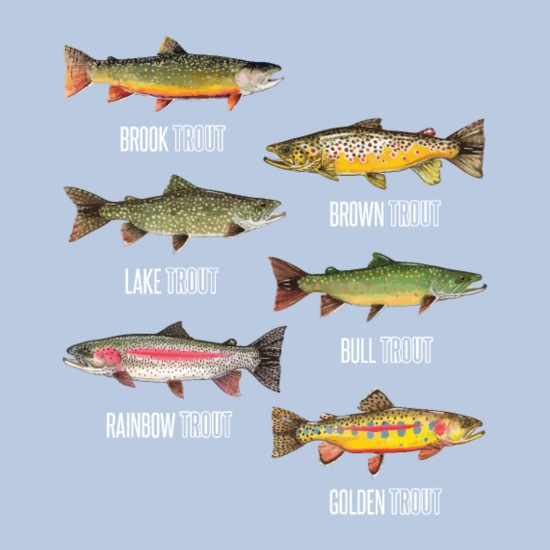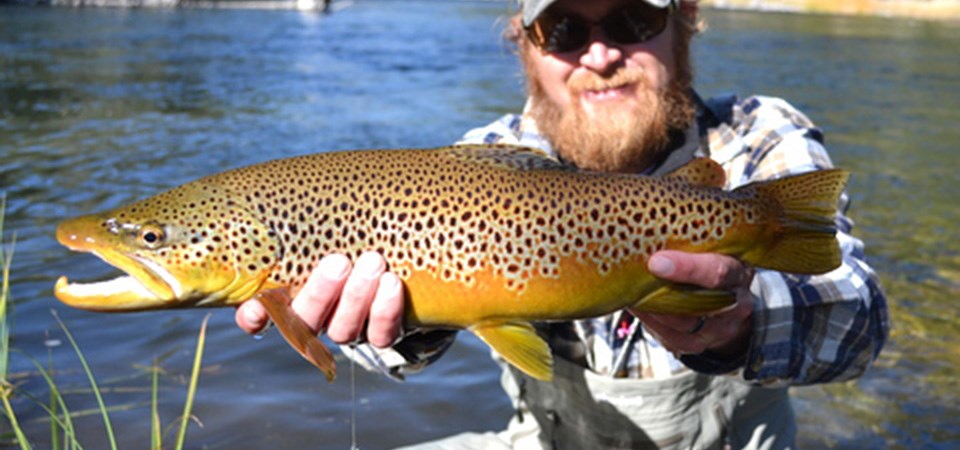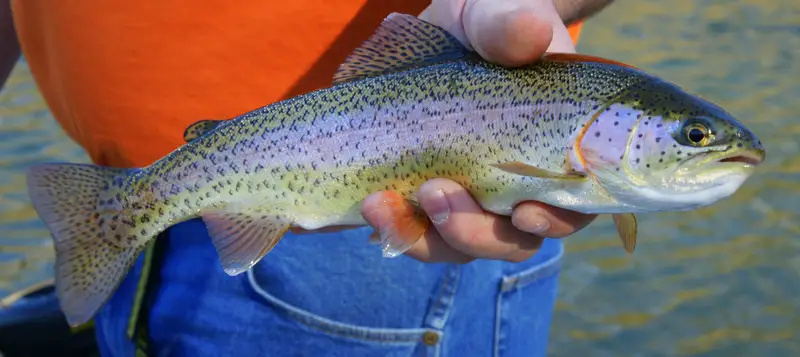Trout is mainly a freshwater fish of the salmon family, found in both Eurasia and North America and highly valued as food and game. Trout is part of the salmon family, found in streams, lakes, and oceans around the world. Chances are one of your first experiences of fishing might have been with one of the common species of Trout. How do you tell the difference between species of Trout?
3 primary species of trout:
Brown Trout-brownish-yellow color-scattered black, red,& orange spots on their sides-12″ long or less
Brook Trout-(Speckled trout) brown with reddish fins & white tips-8″ long or less
Rainbow Trout-dark back & white belly-pink stripe down middle-up to 12″ long are common
Trout are usually found in cool (50–60 °F or 10–16 °C), clear streams, and lakes, although many of the species have anadromous strains as well. Young trout are referred to as troutlet, troutling, or fry. Trout can have many different colors these colors and patterns form as camouflage, based on the surroundings, and will change as the fish moves to different habitats.
Trout Identification
A chiefly freshwater fish of the salmon family, found in both Eurasia and North America and highly valued as food and game. Trout have large mouths and teeth. The males develop a hooked lower jaw called a kype. They can grow in size to nearly 30 pounds, but the wildest trout stay on the smaller side, averaging around six inches long.
They have an extra adipose fin between the dorsal and tail fin, which can be forked or square-shaped. There is a numerous array of trout species like Steelhead, Golden, and Cutthroat trout that are hybrid fish found all over the world. The most common Trout species found in North America are:

Rainbow trout
Have a dark back and white belly with a distinctive pink stripe down the middle. They can be quite aggressive and are renowned for their attractive and colorful patterned skin and their remarkable ability to swim swiftly upstream.
Distinguished by the presence of a pinkish to red longitudinal band, varying numbers of black spots, and a frequently pink or red gill cover. They are a very popular game fish in North America. Fish sizes up to 12 inches long are common, and occasionally larger specimens are taken.
Steelhead trout are the anadromous form of rainbow trout. Rainbow trout can remain in freshwater their entire lives, or they can migrate to the ocean and then return to freshwater to spawn.
Brown Trout

Brown or Speckled trout are brownish in overall tone. Brown trout can be distinguished by their brownish-yellow color and the scattered black, red, and orange spots on their sides. Large, dark spots are outlined with pale halos on the sides, the back, and the dorsal fin, with reddish-orange or yellow spots scattered on the sides.
Brown trout prefer larger, slower-flowing streams with large stones or fallen trees to provide cover. However, they also do well in some of the smaller, swifter streams too. Brown trout are stubborn fighters when hooked, but do not put on as spectacular an acrobatic show as the rainbow. Instead, they tend to go to the bottom and run underneath a log or into a rock crevice.
Brook Trout

Brook Trout is brown with reddish fins and white tips. This species of trout is native to the Northeastern region of the United States, “brookies” (as they’re commonly known), have been introduced to the western states as well. Most brook trout live to be about 5 years old and stay under 12 inches in size, a typical brook trout caught today is small in size about eight inches or less in length.
The larger brook trout can actually live to be over 10 years. Brook trout are a popular angling fish, especially for those who enjoy fly fishing. This trout species has a long history in the United States specifically
Trout are cold-blooded animals. When the weather turns from warm to freezing, their metabolism slows down, meaning they can eat less during the winter months. As water levels lower, the trout moves to find a deep pool where the current is slow and ice is less likely to form. Rainbow trout are the most common sportfish in North America.
These trout are native to the west coast, Alaska, and British Columbia but now can be found in streams and lakes throughout North America, Rainbows are the most common hatchery fish and are stocked throughout the United States.
Rather than having rows of teeth on both jaws like many prey-eating mammals, all trout grow a strip of vomerine teeth on the roof of their upper jaw. These kinds of teeth are typically found in carnivorous fish, who use them to hold onto prey and move it down their throat.
It’s the night before the greatest day of a 14-year-old boy’s life, no, not Christmas it’s the night before the Opening Season of Trout. You buy the latest tackle and lures along with fresh live bait the night before you and your buddies start the long walk down to the freshly stocked lake early to get a good spot, telling stories about catching your limit in the cold April air where the stocked trout are hungry and jumping out of the near-freezing water when we get there.
Make a great fishing story to look back on for yourself or your kids. or your grandkids! Take them Trout fishing!
What is the Best Water Temperature for Trout activity?
Trout are cold-blooded fish that prefer to live & feed in colder H2O around 53°F which holds more dissolved oxygen but as H2O warms, oxygen begins to dissipate, and trout become less active and will move up & down in the water column or to a different location to find colder temperatures.…………………………………………………………. Read more
JimGalloway Author/Editor

References: Animal Diversity Web
